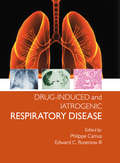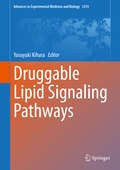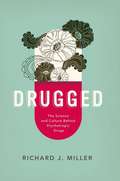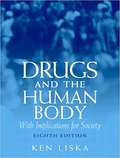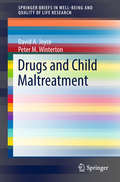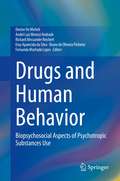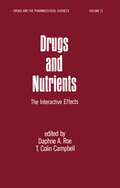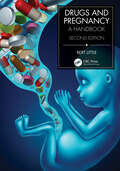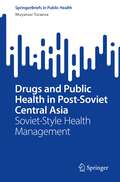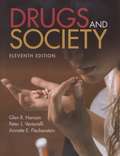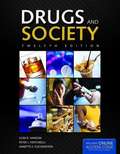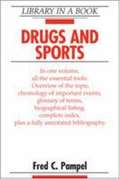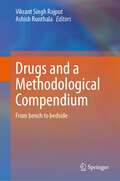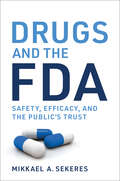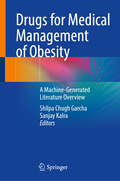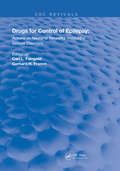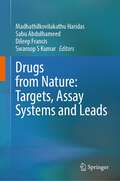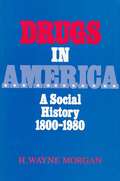- Table View
- List View
Drug-induced and Iatrogenic Respiratory Disease
by Phillipe Camus Edward Rosenow IIIAt the present time, 430 drugs are known to cause respiratory injury. This represents an increase of almost 200 in the last ten years, and the number is still increasing. This comprehensive, definitive reference work, with an outstanding range of international expert contributors and two of the world's leading editors, provides an essential referen
Drug-related problems in the elderly
by Annika Kragh Patrik Midlöv Tommy ErikssonThe number of elderly is increasing in the developed part of the world. With increasing age the prevalence of many diseases will increase. This promotes high use of drugs. For all health care professionals, it is essential to be aware of the possible risks and difficulties with drugs in the elderly. In this book, the authors describe these difficulties from several aspects. Evidence based medicine and elderly, physiological alterations with age that affects pharmacology, specific conditions and drugs that are troublesome in the elderly as well as organisational shortcomings are covered. The authors are pharmacist and physicians and active as researchers, university teachers, and practitioners, with special focus on drugs in the elderly. They describe problems, but also possible solutions and aids in the pharmacotherapy of elderly. Drug-related problems in the elderly is written as a teaching text for students in different courses in the fields of pharmacology or geriatrics. It is also intended to serve as a source of information and clinical support in geriatric pharmacotherapy for students as well as all health care professionals, e.g. physicians, nurses and pharmacists.
Druggable Lipid Signaling Pathways (Advances in Experimental Medicine and Biology #1274)
by Yasuyuki KiharaLipids are responsible not just for constituting cellular membrane but also for storing energy, transducing signaling, and modifying proteins. Bioactive lipids, or lipid mediators, transduce signaling as intracellular messenger like phosphoinoitides, and also regulate cell-cell communication through G protein-coupled receptors (GPCRs) that are potentially valuable drug targets in many diseases. Until now, about 40 GPCRs within ~300 rhodopsin-like (class A) GPCRs, are identified as lipid GPCRs. Advances of lipid research have enabled to develop novel small molecules targeting lipid GPCRs for several diseases. Most notably, fingolimod (FTY720), a sphingosine 1-phosphate (S1P) receptor modulator, became the first FDA-approved medicine as an orally bioavailable drug for treating relapsing forms of multiple sclerosis (MS). In addition to fingolimod, other drugs targeting lipid GPCRs had been developed such as latanoprost (prostaglandin F2a analogue, used for ocular hypertension and glaucoma), epoprostenol and treprostinil (prostaglandin I2 analogue, used for pulmonary arterial hypertension), montelukast and pranlukast (cysteinyl leukotriene receptor antagonist, used for asthma and allergies), etc. Novel drugs are also expected like lysophosphatidic acid (LPA) receptor antagonist for treatment of pulmonary fibrosis. Drug development targeting lipid signalling pathways are backdated to more than a century, when aspirin was synthesized and selling by Bayer, while the basic mechanism of aspirin's effects (block prostanoid synthesis by inhibiting cyclooxygenases) had not been discovered until 1970s. Nowadays, non-steroidal anti-inflammatory drugs (NSAIDs) like aspirin and ibuprophen are commonly used as antipyretic analgesics and available readily over-the-counter oral drugs. Both upstream and downstream enzymes, such as phospholipase A2s and prostaglandin E synthases, respectively, are also potential therapeutic targets for inflammatory diseases. Recent studies of lipid metabolism expand the lipid biology field from pro-inflammatory lipid mediators to anti-inflammatory epoxy fatty acids (epoxyeicosatrienoic acids), and also omega-3 fatty acid-derived pro-resolving lipid mediators (lipoxin, resolvin, and neuroprotectin). These bioactive lipids, their metabolic pathways and receptors are of great interest in developing next-generation anti-inflammatory and pro-resolving drugs for a wide variety of diseases including. This book summarizes not only historical overview of lipid signaling pathways but also provides summary of cutting-edge studies that may provide some hints of novel “druggable” lipid signaling targets.
Drugged: The Science And Culture Behind Psychotropic Drugs
by Richard J. Miller"Morphine," writes Richard J. Miller, "is the most significant chemical substance mankind has ever encountered." So ancient that remains of poppies have been found in Neolithic tombs, it is the most effective drug ever discovered for treating pain. "Whatever advances are made in medicine," Miller adds, "nothing could really be more important than that." And yet, when it comes to mind-altering substances, morphine is only a cc or two in a vast river that flows through human civilization, ranging LSD to a morning cup of tea. In DRUGGED, Miller takes readers on an eye-opening tour of psychotropic drugs, describing the various kinds, how they were discovered and developed, and how they have played multiple roles in virtually every culture. The vast scope of chemicals that cross the blood-brain barrier boggle the very brain they reach: cannabis and cocaine, antipsychotics and antidepressants, alcohol, amphetamines, and Ecstasy-and much more. Literate and wide-ranging, Miller weaves together science and history, telling the story of the undercover theft of 20,000 tea plants from China by a British spy, for example, the European discovery of coffee and chocolate, and how James Wolfgang von Goethe, the famous man of letters, first isolated the alkaloid we now know as caffeine. Miller explains what scientists know-and don't-about the impact of each drug on the brain, down to the details of neurotransmitters and their receptors. He clarifies the differences between morphine and heroin, mescaline and LSD, and other similar substances. Drugged brims with surprises, revealing the fact that antidepressant drugs evolved from the rocket fuel that shot V2 rockets into London during World War II, highlighting the role of hallucinogens in the history of religion, and asking whether Prozac can help depressed cats. Entertaining and authoritative, Drugged is a truly fascinating book.
Drugging France: Mind-Altering Medicine in the Long Nineteenth Century (Intoxicating Histories)
by Sara E. BlackIn the nineteenth century, drug consumption permeated French society to produce a new norm: the chemical enhancement of modern life. French citizens empowered themselves by seeking pharmaceutical relief for their suffering and engaging in self-medication. Doctors and pharmacists, meanwhile, fashioned themselves as gatekeepers to these potent drugs, claiming that their expertise could shield the public from accidental harm. Despite these efforts, the unanticipated phenomenon of addiction laid bare both the embodied nature of the modern self and the inherent instability of the notions of individual free will and responsibility.Drugging France explores the history of mind-altering drugs in medical practice between 1840 and 1920, highlighting the intricate medical histories of opium, morphine, ether, chloroform, cocaine, and hashish. While most drug histories focus on how drugs became regulated and criminalized as dangerous addictive substances, Sara Black instead traces the spread of these drugs through French society, demonstrating how new therapeutic norms and practices of drug consumption transformed the lives of French citizens as they came to expect and even demand pharmaceutical solutions to their pain. Through self-experimentation, doctors developed new knowledge about these drugs, transforming exotic botanical substances and unpredictable chemicals into reliable pharmaceutical commodities that would act on the mind and body to modify pain, sensation, and consciousness.From the pharmacy counter to the boudoir, from the courtroom to the operating theatre, from the battlefield to the birthing chamber, Drugging France explores how everyday encounters with drugs reconfigured how people experienced their own minds and bodies.
Drugs And The Human Body
by Ken LiskaClear and readable for the average reader – yet comprehensive enough for the professional – this reliable reference addresses the effects of high-use, high-abuse drugs in America in a timely and straightforward fashion. Reflects up-to-date research throughout, including coverage of street, over-the-counter, and prescriptive drugs. Highlights the World Wide Web as a growing primary source of drug information. Extensively revises coverage of drug discovery, including major additional information on proteomics, and pharmacogenomics; and highlights the importance of these topics in the context of personalized drug treatment. For professionals in health and drug education, criminal justice, sociology, biology, and chemistry.
Drugs Easily Explained
by Roland SeifertBillions of people worldwide take medicines every day to treat important diseases. In many cases, however, neither the doctor nor the pharmacist has the time to explain to the patient why a particular drug should be taken, how the drug works and what side effects to expect. Of course, the patient can find "everything" about a particular drug on the Internet. But how reliable and understandable is this information? In addition, most Internet sources do not point out the interrelationships between different diseases and drug interactions. Written by an experienced and well-known textbook author, this book provides an overview of the most common diseases and the drugs used to treat them. The book is designed for a general audience. It provides patients with essential information about how medications work and what side effects and interactions to expect. Finally, the book gives patients advice on what they can do themselves to improve drug therapy and safety. Summaries, bullet points, tables and diagrams support the information process.
Drugs Targeting B-Cells in Autoimmune Diseases
by Munther A. Khamashta Manuel Ramos-Casals Xavier BoschThis book provides a detailed overview of B-cell directed therapies in patients with rheumatic and systemic autoimmune diseases, including rheumatoid arthritis, systemic lupus erythematosus, Sjögren syndrome, ANCA-associated vasculitis and cryoglobulinemia. Organ-specific autoimmune diseases are discussed with respect to the use of B-cell directed therapies in neurological autoimmune diseases and autoimmune cytopenias. Situations in which B-cell targeted therapy may be indicated are identified, thereby offering comprehensive support for therapeutic decisions on the basis of the latest published evidence. The book also offers a valuable reference tool for rheumatologists, internists, nephrologists, immunologists, and all specialists involved in the multidisciplinary care of patients with rheumatic and systemic autoimmune diseases.
Drugs That Changed the World: How Therapeutic Agents Shaped Our Lives
by Irwin W. ShermanDrugs are used in the diagnosis, alleviation, treatment, prevention or cure of disease. This is a book about drugs, how they came to be, and how they exert their ‘magic’. Today we have drugs to protect against infectious diseases, to alleviate aches and pains, to allow new organs to replace the old, and for brain functions to be modified. Yet, for the most part the manner by which drugs are developed and by whom remains a mystery. Drugs are more than just a pill or liquid and some have markedly altered history. The author has selected a few drugs – highlights representing milestones affecting our well-being and influencers of social change. The stories told are dramatic and include spectacular successes and dismal failures. And the people about whom these stories are told are both saints and sinners – selfless and conniving – bold and mercurial and shy and retiring loner. The drugs themselves mirror the diversity of their origin stories and the author assembles all sides of these fascinating stories.
Drugs and Child Maltreatment (SpringerBriefs in Well-Being and Quality of Life Research)
by David A. Joyce Peter M. WintertonThis book combines experience in child protection with expertise in clinical pharmacology and forensic toxicology, to set out a broad contemporary understanding of child maltreatment with drugs. It explores presentations that range through ante-natal exposure, factitious illness, deliberate poisoning, drug accidents while in the care of drug-affected adults, misuse of therapeutic drugs and the drug-related death of a child. It describes how to recognise where deliberate drug exposure or perversion of proper therapeutics is being used to harm a child, how to use laboratory testing to confirm a diagnosis, how to combine medical and social care with the need to gather legal evidence and how to deploy social, medical and legal resources for child protection. The roles of the forensic toxicologist and contemporary forensic laboratory methods in resolving cryptic presentations are discussed in each context. There is guidance on effective communication about drugs within the child protection team and on writing reports for legal purposes, on the way to returning the child to safety. The book also explores the particular difficulties that arise in reconciling parents' rights and cultural beliefs with the obligation to document a child’s drug exposure and in dealing with parents and carers who themselves may be drug-impaired.
Drugs and Human Behavior: Biopsychosocial Aspects of Psychotropic Substances Use
by André Luiz Monezi Andrade Eroy Aparecida da Silva Denise De Micheli Fernanda Machado Lopes Bruno de Oliveira Pinheiro Richard Alecsander ReichertThis book presents the main concepts and tools for the adoption of a biopsychosocial approach to psychotropic substances use and abuse management, prevention and treatment. It aims to provide resources for the design and implementation of health strategies and public policies to deal with psychotropic substances use in a way that fully recognizes the complex articulations between its biological, psychological and social aspects, taking these three dimensions into account to develop both health and social care policies and strategies aimed at psychotropic substance users. The book is organized in five parts. Part one presents a historical overview of psychotropic substances use throughout human history and introduces key concepts to understand the phenomenon from a biopsychosocial perspective. The next three parts approach psychotropic substances use from one of the interrelated dimensions of the biopsychosocial perspective: part two focuses on the neurobiological aspects; part three, on the psychological aspects; and part four, on the social aspects and its implications for public policy design. Finally, a fifth part is dedicated to special topics related to psychotropic substances use. Drugs and Human Behavior: Biopsychosocial Aspects of Psychotropic Substances Use is a guide to public agents, health professionals and social workers interested in adopting the biopsychosocial perspective to develop and implement both health and social care strategies and policies based on an interdisciplinary approach and aimed at dealing with psychotropic substance users in a more humanized way.
Drugs and Nutrients: The Interactive Effects
by D. A. RoeThis book is devoted to the effects of food and of nutrient intake on the disposition of foreign compounds, and discusses effects of drugs on nutrition. It is intended for nutritionists and clinical investigators concerned with interpretation of aberrant effects of therapeutic drugs.
Drugs and Pregnancy: A Handbook
by Bertis B. LittleThis practical handbook provides detailed guidelines on prescribing drugs in all classes and for a wide variety of diseases and disorders during pregnancy, with numerous boxes and tables to assist understanding. CONTENTS: Introduction to Drugs in Pregnancy * Antimicrobials during Pregnancy: Bacterial, Viral, Fungal, and Parasitic Indications * Cardiovascular Drugs during Pregnancy * Endocrine Disorders, Contraception, and Hormone Therapy during Pregnancy: Embryotoxic versus Fetal Effects * Antiasthma Agents during Pregnancy * Anesthetic Agents and Surgery during Pregnancy * Antineoplastic Drugs during Pregnancy * Analgesics during Pregnancy * Anticonvulsant Drugs during Pregnancy * Psychotropic Use during Pregnancy * Antihistamines, Decongestants, and Expectorants during Pregnancy * Nutritional and Dietary Supplementation during Pregnancy * Use of Dermatologics during Pregnancy * Drug Overdoses during Pregnancy * Miscellaneous Drugs during Pregnancy: Tocolytics, Immunosuppressants, and Biologic Therapeutics * Substance Abuse during Pregnancy * Online Support Material
Drugs and Public Health in Post-Soviet Central Asia: Soviet-Style Health Management (SpringerBriefs in Public Health)
by Muyassar TuraevaThe book outlines post-Soviet style of health management in Central Asia. Regional studies on Central Asia to date have focused on states, politics, religion and inter-ethnic relations but not on the health system within the region. Soviet-style policies have also covered only other aspects relevant for the region. This book highlights the public health situation of the region with a focus on drug abuse, HIV/AIDS in the context of increased mobility, and drug trafficking routes which became even more porous after the break-up of the Soviet Union. Based on a qualitative study, the empirical data in the book was collected during long-term fieldwork conducted in Uzbekistan and Turkmenistan in 2010-2011 as well as shorter stays in Uzbekistan between 2012-2016. The analysis of the empirical material largely draws on the works of Foucault, particularly his concept of biopolitics when analyzing Soviet-style health management that is still practiced in the region. Applying the Foucauldian genealogical method, this study has been structured to trace the genealogy of epidemics to understand the historical path of drug abuse in the region as well as the discursive genealogy of drug politics and drug abuse. Applying the same genealogical method of Foucault, the formative and discursive trajectory of the institution of Uchyot was traced to contextualize the health governance methods that have historical legacy of Soviet-style governance and control of the total population. Drugs and Public Health in Post-Soviet Central Asia: Soviet-Style Health Management is a unique resource for academic specialists, practitioners/professionals, and advanced undergraduate and graduate students in public health, as well as a range of scholars and professionals in sociology, political science, anthropology, and anyone with an interest in the Central Asia region, drug addiction, or HIV. The book also could appeal to international donors in the field of HIV/drug addiction who are working in the region.
Drugs and Society
by Glen R. Hanson Annette E. Fleckenstein Peter J. VenturelliThoroughly revised and updated, Drugs and Society, Eleventh Edition, contains the most current information available concerning drug use and abuse. Written in an objective and user-friendly manner, this best-selling text continues to captivate students by taking a multidisciplinary approach to the impact of drug use and abuse on the lives of ordinary people. The Eleventh Edition incorporates the authors#146; combined expertise in pharmacology, drug abuse, and sociology and extensive experience in research, teaching, drug policy-making, and drug policy implementation and includes hundreds of new citations that reflect the current state of drug abuse issues and the rapidly changing issues of substance abuse/addiction.
Drugs and Society
by Glen R. Hanson Annette E. Fleckenstein Peter J. VenturelliUpdated to keep pace with the latest data and statistics, Drugs and Society, Twelfth Edition, contains the most current information available concerning drug use and abuse. Written in an objective and user-friendly manner, this best-selling text continues to captivate students by taking a multidisciplinary approach to the impact of drug use and abuse on the lives of average individuals.
Drugs and Sports
by Fred C. PampelPampel (sociology, University of Colorado) chronicles the use of performance-enhancing drugs in American sports, and reviews the major laws and court cases involving drug use and testing. Extensive reference chapters provide brief biographical sketches of players and scientists, cite books and articles on both medical and social aspects of the issue, and list government and sports agencies. Appendices reprint the Anabolic Steroid Control Acts, the Supreme Court decision on drug testing of student athletes, and NIDA research reports. Annotation ©2007 Book News, Inc., Portland, OR (booknews.com)
Drugs and a Methodological Compendium: From bench to bedside
by Vikrant Singh Rajput Ashish RunthalaThis book provides a meticulous view on methodological drug discovery and development insights from bench to bedside. The current book threads almost each step encompassing drug the discovery and development of a molecule. The chapters focus on computational modus operandi, pharmacological optimization approaches, modern high-throughput screening methods and in-vitro procedures, role of structural biologists in drug discovery and development, medicinal chemistry approaches for drug design, formulation and drug delivery, in-vivo evaluations of candidate molecules, clinical trial procedures and others. The book also covers specific case studies, regulatory approval proceedings, and industrial view point alongside the aforementioned conceptual layout. And at the same time, the volume integrates medical, biological, medicinal, pharmacological and computational streams, and it is suggested as an ideal guideline to a wide audience including molecular biologists, biochemist, pharmacologists, medicinal chemist, toxicologists, drug discovery and development researchers, and all other students interested in these disciplines.
Drugs and the FDA: Safety, Efficacy, and the Public's Trust
by Mikkael A. SekeresHow the FDA was shaped by public health crises and patient advocacy, told against a background of the contentious hearings on the breast cancer drug Avastin.Food and Drug Administration approval for COVID-19 vaccines and the controversial Alzheimer&’s drug Aduhelm made headlines, but few of us know much about how the agency does its work. Why is the FDA the ultimate US authority on a drug&’s safety and efficacy? In Drugs and the FDA, Mikkael Sekeres—a leading oncologist and former chair of the FDA&’s cancer drug advisory committee—tells the story of how the FDA became the most trusted regulatory agency in the world. It took a series of tragedies and health crises, as well as patient advocacy, for the government to take responsibility for ensuring the efficacy and safety of drugs and medical devices. Before the FDA existed, drug makers could hawk any potion, claim treatment of any ailment, and make any promise on a label. But then, throughout the twentieth century, the government was forced to take action when children were poisoned by contaminated diphtheria and smallpox vaccines, an early antibiotic contained antifreeze, a drug prescribed for morning sickness in pregnancy caused babies to be born disfigured, and access to AIDS drugs was limited to a few clinical trials while thousands died. Sekeres describes all these events against the backdrop of the contentious 2011 hearings on the breast cancer drug Avastin, in which he participated as a panel member. The Avastin hearings, he says, put to the test a century of the FDA&’s evolution, demonstrating how its system of checks and balances works—or doesn&’t work.
Drugs as Tools in Neurotransmitter Research
by Alan A. Boulton Glen B. Baker Augusto V. JuorioChapters deal with the use of neurotoxins for the study of catecholamine, 5-hydrotryptamine, and cholinergic pathways. Also examined are the effects of drugs that interfere with monoamine storage, techniques available for the estimation of the metabolism of monoamines and acetylcholine, as well as behavioral and biochemical models of disease. Annotation(c) 2003 Book News, Inc. , Portland, OR (booknews. com)
Drugs for HER-2-positive Breast Cancer
by Christoph C. Zielinski Rupert Bartsch Thomas W. Grunt Maria SibiliaGrowth factor receptors have long been known to drive malignant transformation and cancer progression. The epidermal growth factor receptor (EGFR, ErbB, HER) system is likely the best described membrane receptor tyrosine kinase family in malignant tumors. With implementation of the growth-inhibitory anti-HER-2 antibody trastuzumab (Herceptin) for the treatment of HER-2-positive advanced metastatic breast cancer, a new era has dawned in the therapy of this malignant disease. Unfortunately, trastuzumab-sensitive cancers invariably develop resistance to the antibody after some time. Recent clinical studies have revealed that these refractory tumors are still responsive to inhibition of the HER receptor family using dual HER-1/-2 inhibitors such as lapatinib (Tykerb/Tyverb). Moreover, a multiplicity of novel, improved irreversibly acting small molecular HER tyrosine kinase inhibitors are in the pipeline of many drug developing companies and are being evaluated in the clinical setting.
Drugs for Medical Management of Obesity: A Machine-Generated Literature Overview
by Sanjay Kalra Shilpa Chugh GarchaThis book covers pharmacological activity and the role of the medications used for the medical management of obesity. The chapters provide information on the prevalence of obesity, basic principles of obesity management, a brief history of anti-obesity medications (AOMs), and discontinuation of AOMs due to their safety concerns. Further chapters include information on currently approved AOMs for obesity management by healthcare regulatory authorities including their effect on weight loss and other important clinical parameters, short-term and long-term use of AOMs, medications for genetic obesity, and the use of AOMs in obesity with associated co-morbidities as per their safety considerations and contraindications. A separate chapter is on drugs that are either under a clinical trial phase or awaiting approval. The auto-summaries have been generated by a recursive clustering algorithm via the Dimensions Auto-summarizer by Digital Science handled by Subject Matter Experts and the external editor. The editor of this book selected which SN content should be auto-summarized and decided its order of appearance. Please be aware that the auto-summaries consist of original sentences, but are not representative of the original paper, since we do not show the full length of the publication. Please note that only published SN content is represented here and that machine-generated books are still at an experimental stage The book is relevant for healthcare and pharmaceutical professionals.
Drugs for the Control of Epilepsy: Actions on Neuronal Networks Involved in Seizure Disorders (Routledge Revivals)
by Carl L. Faingold Gerhard H. FrommOriginally published in 1991. This book brings together the ideas of an international group of experts on clinical and experimental epilepsy. These authors consider how antiepileptic drugs may act on elements of neuronal networks to reduce seizure incidence and severity. The book addresses such topics as the four general classes of anticonvulsant drug mechanisms, major epilepsy models, the proposed mechanisms of action of major antiepileptic drugs, and the clinical use of antiepileptic drugs in the treatment of various forms of human epilepsy. This volume is special for its focus on the neuronal network approach to epilepsy, as well as for its comprehensive review and integration of human and animal data. Neurologists, pharmacologists, psychiatrists, and other investigators actively working on epilepsy research will find this book to be a useful, thought-provoking reference volume.
Drugs from Nature: Targets, Assay Systems and Leads
by Sabu Abdulhameed Madhathilkovilakathu Haridas Dileep Francis Swaroop S KumarThis book provides an overview of the drug discovery process from natural sources such as plants and microbes. While technological advances have streamlined the drug discovery process, enhancing the throughput and success rates, the structural features of natural products remain the primary reference for small-molecule drug discovery. Focusing on the drug targets blocked/altered by natural/nature-inspired molecules, it covers how potential drug leads are screened and identified using appropriate assay systems, and the current status of drugs identified using such approaches. State-of-the-art approaches in target identification, assay development, and lead identification have also been discussed in detail. Other topics included are targets and leads in inflammation, cancer, reproductive medicine, cardiovascular and neuromuscular ailments, and infectious diseases as well as the challenges in translating drug leads into clinically viable drugs. This volume serves as a handbook for researchers in phytochemistry and drug discovery, and as a reference for researchers and students of applied biology.
Drugs in America: A Social History, 1800-1980
by H. Wayne MorganThis book developed out of my general interest in the late nineteenth century. While reading through the popular press in connection with another project, I discovered a great deal of comment on the "opium problem," and on drug use in general. I unearthed several addict memoirs and other unusual sources, and the medical literature proved a gold mine of information. After further research, it seemed to me that a brief general survey of the question with some depth and fresh information was in order, and this book is the result.
